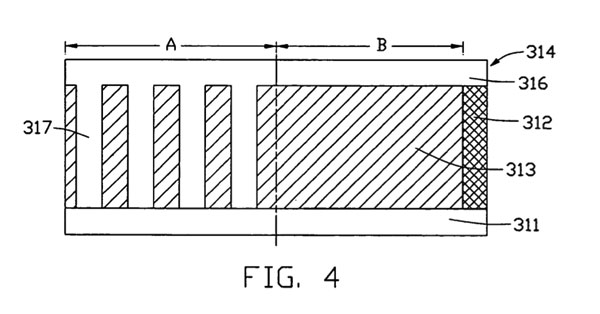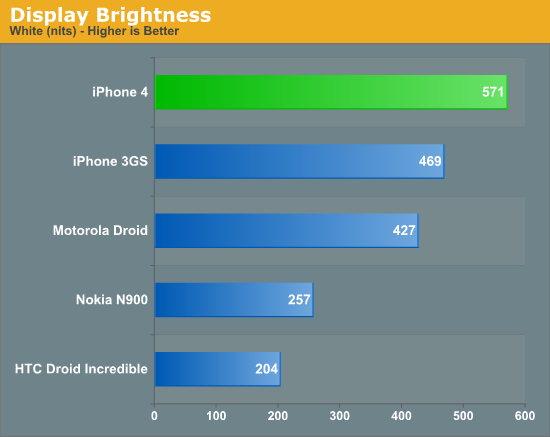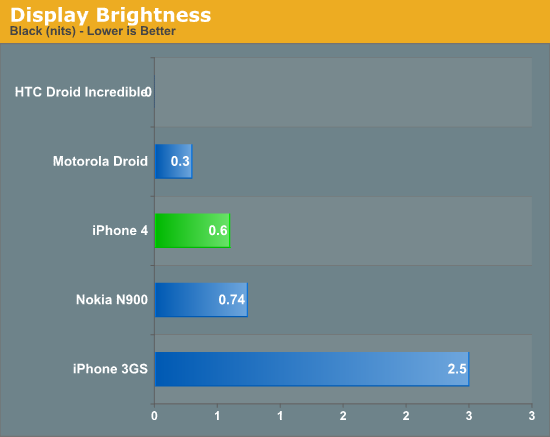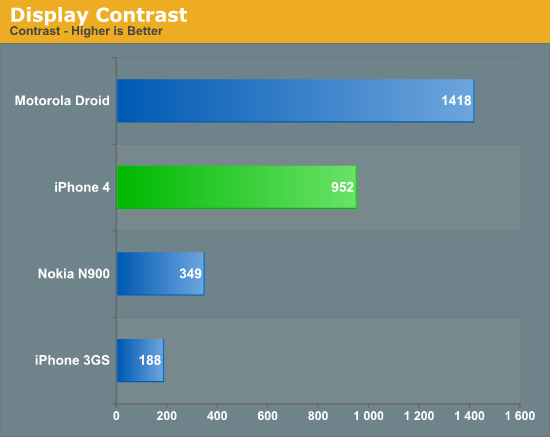Apple's iPhone 4: Thoroughly Reviewed
by Brian Klug & Anand Lal Shimpi on June 30, 2010 4:06 AM EST- Posted in
- Smartphones
- Apple
- iPhone 4
- Gadgets
- Mobile
More Display
It's obvious how Apple settled on 960x640; it's four times the resolution of the previous iPhones. However, instead of decreasing text size, iOS 4 scales appropriately, and the size of everything remains the same. The result is that there are small details everywhere that pop out. Apple's icons on the home screen are the first that really pop out, and new iOS 4 optimized applications will bring that increased detail as developers add higher resolution artwork.
The display panel itself uses a subset of IPS (In Plane Switching) display technology called Fringe Field Switching (FFS). Where IPS switches the crystal polarization in the plane of the display with two opposing electrical substrates composed of semi opaque metals (which decreases transmission and viewing angles), FFS uses considerably less metal by arranging the electrodes in a comb like structure.

See that - it almost looks like a comb. Or an impulse train. Or Dirac comb. So many combs.
The result is that there's considerably less metal in back and in front of the pixel, resulting in much higher transmission of light through the display, and higher brightness for a given backlight level. Using FFS to drive pixel switching is critical here because of the high dot pitch in the iPhone 4's display.
The other interesting difference between iPhone 4's retina display and previous displays is that the digitizer is in optical contact with the display itself. There's no longer an air gap, and as a result, no longer any opportunity for dust to gradually work its way inbetween. Over time, I've noticed a few dust specks creep in on my 3GS, it does happen. The digitizer and display panel are essentially laminated together. The added benefit is that fewer material interfaces results in fewer internal reflections - think the "super" in Super AMOLED but applied to TFT. That's what Apple has done here.
Apple is using Corning's Gorilla glass which touts hugely increased scratch resistance and robustness. Both the front and back of the iPhone 4 are that same type of glass. I've noticed a few superficial scratches (called sleeks) that have appeared on the back, but really the true test will be how the phone looks after 6 months in the pocket. It's interesting that the iPhone capacity markings have disappeared from the back of the phone - no doubt this was done so Apple could make one part and one part only for each color.
The rest of the details are in the specifications. Apple advertises increased brightness of 500 nits and a contrast ratio of 800:1. We measured, and our iPhone 4 exceeded specs at 571 nits and just under 1000:1 contrast ratio.



Note that the HTC EVO 4G is missing as Anand has it, but it's on its way to me. As soon as I get it, I'll measure display brightness, black point, and contrast and update these results. In addition, the HTC Droid Incredible (and thus Nexus One) contrast is effectively infinity by the way we calculate, due to pixels being completely turned off in the black state. In addition, I'm led to believe that the AMOLED's PenTile grid throws off our numbers when measuring brightness. I've run and rerun this test, it keeps coming up that way.
Next to the iPhone 4, the 3GS display really shows its age. It leaks light when displaying black, with an absurdly high black point of nearly 3 nits. Just looking at the lock screen on the iPhone 4 next to the 3GS it's readily apparent how much better blacks are. iPhone 4 easily bests the 3GS but still isn't quite as contrasty as the Incredible or Nexus One AMOLED displays, or the IPS in the Motorola Droid. You do get higher resolution and brightness, however, but nothing is free.
Going from the iPhone 4's display back to the 3GS is pretty painful, but going back to even relatively high dot pitch displays on the desktop is painful as well. Even on the "high resolution" MacBook Pro with 1680x1050 display, displaying an iPhone 4 screenshot at native resolution uses up 91% of the height. If there's one thing I hope the iPhone 4 display does, it's generate demand for 300 PPI level desktop displays - the era of 110 PPI displays being the norm needs to end now.










270 Comments
View All Comments
The0ne - Wednesday, June 30, 2010 - link
Actually, Anand likes the performance of the iPhone and i don't blame him. It is smooth, well implemented and thus makes using it more enjoyable, quantifiable or not. Features be damn, what counts is how a user perceives the device he/she is using. And once attached or rather use to them it's hard to like something that isn't the same or better.For the most part, android OS and WebOS are fine for the vast majority of users. The slight sluggish performance is really not hindering anyone from doing anything practical. It is really just a matter of perception.
As for features and design, I can honestly say unless you been in the design phase yourself many decisions are made prior to production. Missing features such as Flash memory support is a choice left out purposely. Don't kid yourself they are doing it because they either can't or because of lack of money/resources.
mesiah - Thursday, July 1, 2010 - link
I don't agree with the flash memory support. Flash memory is so cheap to implement that it comes on the cheapest of cheap products. And before anyone uses the excuse of "a flash port would clutter up the phone and make it look ugly" Look at the huge ugly connector port used to sync / dock an iphone. Compare that to micro usb. You don't think they could shrink that thing to a quarter of its current size, or less, and add in a flash memory port? Hell, A smart engineer could make a docking port that doubles as a flash memory port (makes me wonder why we haven't seen this yet.) The reason you don't get upgradeable flash memory is the same reason you don't get removeable batteries. There isn't money in batteries and memory, the money is in forcing people with outdated hardware to upgrade.The0ne - Thursday, July 1, 2010 - link
Err, I think u might has misread what I was trying to say. As you've stated flash memory support is very easy and cheap to design in. For Apple not to have it means they have purposely decided against it. For example, creative labs has flash support on some of their PMP devices but it is extremely poor in design that it's unusable. That's the other caveat to just putting features in and not properly supporting it.Anand Lal Shimpi - Wednesday, June 30, 2010 - link
By feature parity I was referring to what's new that made it into iPhone 4: higher res screen, 45nm SoC, much improved battery life, smaller form factor. I'd expect that within the next 6 - 12 months we will see Android phones with similar specs.Software feature wise, Android is at parity in most cases and far ahead in others.
Take care,
Anand
darwinosx - Wednesday, June 30, 2010 - link
They you don't know much about either Android, the iPhone 4, or both.Mumrik - Friday, July 2, 2010 - link
Are you aware that your username undermines every single pro Apple comment you make?Also, I think most of us will take Anand's word for it over an anonymous commenter's.
mmike70 - Sunday, July 4, 2010 - link
Why does it undermine?John Sawyer - Thursday, July 1, 2010 - link
The somewhat larger number of pixels in the Retina display that Apple is using in the iPhone 4, plus its smaller size than the Evo and Droid X displays, do combine to make for a massive difference, as the pictures in the article show. I've compared the two, and the iPhone 4 display really is startlingly good. Many things don't look hugely different between the two, such as some videos, larger graphics and text, etc., but small text (which I look at a lot because that's what a lot of websites serve up) certainly does.semo - Wednesday, June 30, 2010 - link
I'm sorry Anand but I just couldn't bring my self to read your review after yet again detecting your bias towards this product. You come from an engineering background and it shows in your methods of analysis which appeals to me.Do you wait 6 hours in line for a new SSD? I detect hints of emotion in this article's introduction. I could be wrong but I always try to avoid technical reading when I suspect there is bias. It is plain to see on other technical sites where the companies' mission statement is part of the introduction but much more subtle here.
I look forward to your next SSD and chip architecture articles.
bplewis24 - Wednesday, June 30, 2010 - link
Anand is about the most objective Apple iPhone fanboy there is. There is no denying this, and it's both a compliment and a criticism. Until he can stop making subjective generalizations like this:"There is this more open, more configurable, more capable feel you get with Android that you don't with the iPhone. That can be both a positive and a negative. Android phones feel more like computers while iPhones have more of that appliance feel. It still boils down to personal preference, the 4 won't change that."
Really, Anand? Being more open and configurable can be a bad thing? We really need to stop perpetuating this myth that Androids can only be liked by "PC" geeks and people who like to dig deep into the OS. The reality is that Android devices don't force you to customize if you don't want to.
I'm also fairly certain that the "scrolling" issue which isn't present on my Moto Droid has something to do with the live wallpapers eating up CPU processing power. Nevertheless, I don't experience it on my phone and to blanketly imply that the OS UI is clunky (which most iPhone fanboys cling to in every comparison) is completely disingenuous.
Until Anand can rid himself of some of this bias, he will still be known as the best and most objective iPHone reviewer on the interwebs, but the title in and of itself won't be saying very much.
Brandon